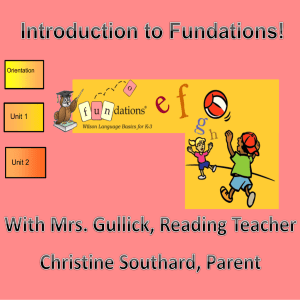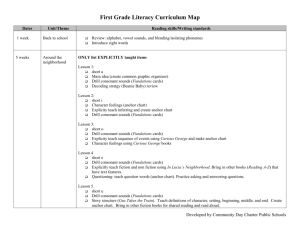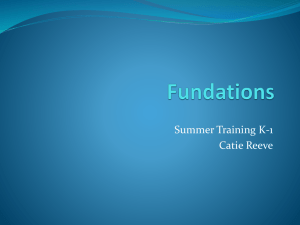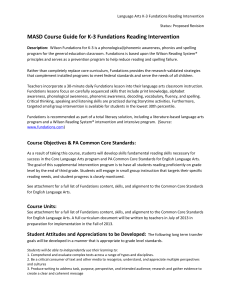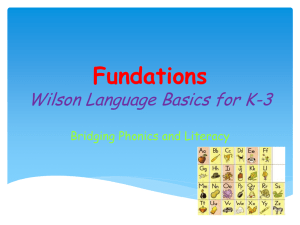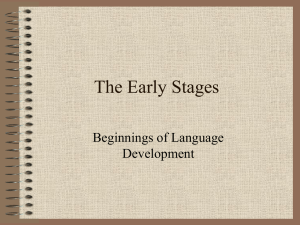fundations powerpoint susan
advertisement
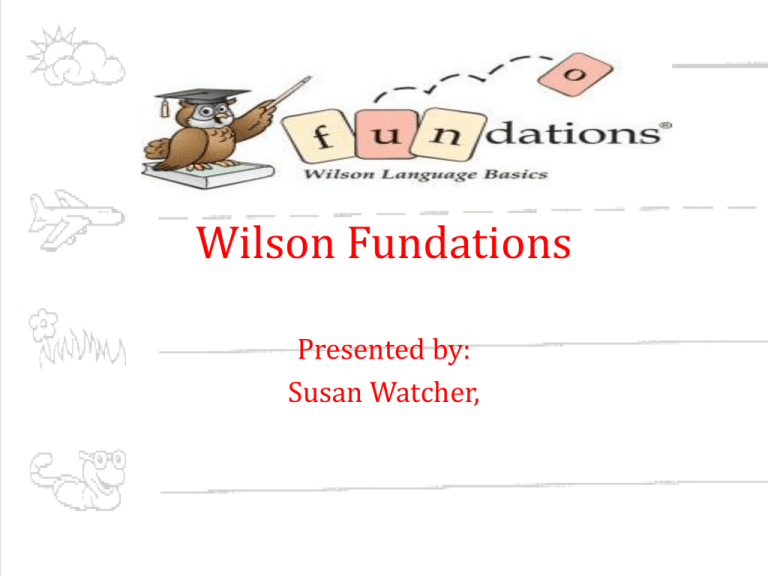
Wilson Fundations Presented by: Susan Watcher, Agenda • • • • Fundations Background Philosophy Principles FUNDATIONS • • • • • • • • • • Fun Understanding Sound/Symbol Relationships National Reading Panel Based Direct and Explicit Instruction Automaticity Tier I and Tier II Instruction Interactive (VAKT) Orton-Gillingham Based Needs Based Systematic and Sequential Fundations Background • • • • • • • Built upon the successes of Wilson Reading System Based on theories of Dr. Orton Barbara Wilson developed the program Collected 10 years of data from schools using Wilson First published in 2002 Used as a preventative and early intervention program Meets the following components of effective reading instruction Phonemic Awareness Phonics Fluency Vocabulary Comprehension Wilson Philosophy • We believe that the ability to read opens up a world of possibilities to the individual. Reading is the door to personal, spiritual and intellectual growth as well as a necessity for a secure future in today's job market. We also believe that literacy is the cornerstone of freedom and democracy. • We at Wilson recognize that teachers are desperate for a solution to the current reading crisis. We understand their frustration. Our goal is to provide teachers with the skills and materials they need to help their students become fluent, independent readers, ready to explore the endless possibilities the world of reading has to offer. • Wilson Language Training Coorporation-2004 • Principles of Wilson Reading System Fundations (from the Wilson Reading Academy) • • • • • • • • • Teach sounds to automaticity Teach total word structure not just sounds Present concepts within context of controlled, written text Present structure of language in a systematic cumulative manner Teach all principles of English language structure directly and thoroughly Teach concepts with (VAKT) methods Teach phonemic and syllabic segmentation Include constant review and repetition Use diagnostic teaching within the scope and sequence of program Grade Level For K-3 Students • • • • Within general education setting Tier I- prevention program ( 25 – 30 minute daily lessons) Tier II- “at risk” program for the lowest 30th percent ( additional double- dose instruction 3-5x a week) Outside the general education setting Tier II for schools not using Fundations in the general education classrooms For the lowest 30th percentile (daily and double dose lessons 3-5x a week) (AEL in Carroll County) Fundations Scope and Sequence Level K • • • • • • • • • • • • • Letter Formation (a-z) Letter names keywords and sounds, short vowels, consonants Word Awareness Print awareness Alphabetic Order Sound Mastery Syllable Awareness Rhyming Phonemic awareness skills ( sound manipulation for initial and final sounds) Blending three sounds to read CVC words beginning with continuous consonants Trick words during second half of year Sentence dictation procedures, capitalization, period, word spacing Sentence proofreading procedures Fundations Scope and Sequene Level I • Review all skills from level K • Trick words from each unit • Concept of consonant diagraph, keyword, and sounds ( sh, ch, th, wh, -ck) • Spelling of “ck” at the end of words • Sentence dictation procedures, question mark • Bonus letters • Glued sounds: all • Glued sounds: an, am • Baseword and suffix with the suffix-s Fundations Scope and Sequence Level I • • • • • • • • Plural nouns Beginning composition skills Glued sounds –ang –ing –ong –ung –ank –ink –onk –unk Blending and reading words with -ng and _nk Concept of syllable Compound words Syllable division rules for closed syllables Long vowel sounds for vowel – consonant – e words Q. Does Fundations meet the Requirements of Reading First? • A. Yes. The Florida Center for Reading Research, one of three federally funded Reading First technical centers, conducted an independent review of Fundations and its effectiveness. The analysis confirmed the alignment with reading research, that Fundations addresses each of the five components required by Reading First ( phonemic awareness, phonics, fluency and comprehension), and noted no weaknesses in the program. Strengths of the Fundations Program • • • • • • • • • • Meets the requirements of Reading First Research based Explicit, systematic and multisensory instruction Carefully sequenced sound/symbol instruction-(ex. Commonly confuse letter sounds b-d, e-i, o-u, and g-j are introduced 2 weeks apart) Addresses the Five Essential Components of Reading Instruction *Phonemic Awareness *Phonics *Fluency *Vocabulary *Comprehension • Can be used to compliment a core reading program , not replace it • Instruction is appropriate for general education students • Instruction for the lowest 30th or “at risk” students can be given in small groups and provides a “double dose” of skill instruction and practice • Handwriting component • Sky line, plane line, grass line and worm line grids with illustrations • Lower case letter instruction before upper case letters • Lower case letters appear more frequently in text Progress Monitoring Feature • Measures students’ response to instruction • Targets students’ with inadequate growth • Identifies areas that need improvement • Provides instructional modification when needed Weaknesses Of Fundations • Volume of materials- manuals, books, journals, cards, DVD, may require the teacher to take a large amount of time becoming familiar with and mastering the program • Training is necessary for the teacher to be effective. More training is needed beyond the 3 day Applied Methods workshop. Training is expensive. • Key word sound/symbol cards have confusing pictures(exfor the letter e a picture of a boy(ed), for the letter i a picture of a monkey itching for itch • Low I.Q. students or those with language processing difficulties may have problems learning the concepts • Too scripted Teachers cannot present the material word for word as recommended. Resources • www.wilsonfundations.com • Fundations Teacher’s Manual Levels K-1, Wilson Language Training Corporation
